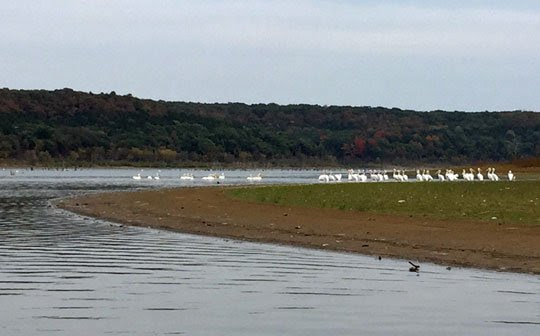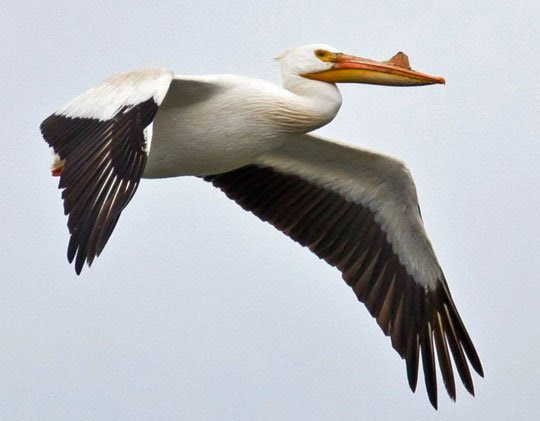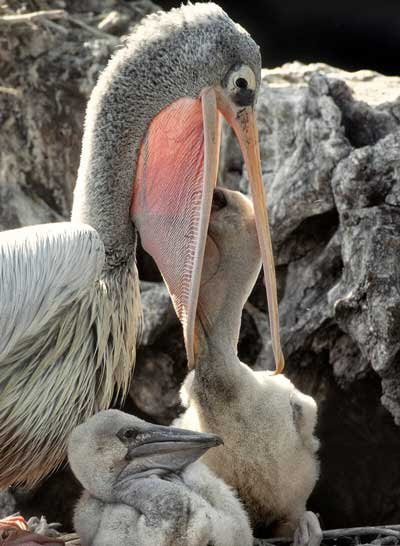|
Here in the midwest U.S. we have a temperate climate, with hot summers and cold winters. In Missouri we are having an unusually warm October. Trish and I are always reluctant to give up our canoeing passion this time of year, so a few days ago we put the canoe in the lake again. Possibly for the last time of the season, but we hope not. We had the joy of observing one of our favorite birds that migrates through this area in the fall... the American White Pelican. These birds are enormous, and they seem majestic as they swim around, searching for fish. These impressive birds have a nine-foot (2.7 m) wingspan, making them one of the largest birds in North America. They gather together in sizable flocks on the shores of the lake, but then when they start looking for food, they often spread out, sometimes a hundred yards apart or so. From a long distance away you can hear them splashing about as they try to catch fish. Here are a few that flew near us: What the heck is a Pelican? Pelicans are a group of eight species in the family Pelecanidae. Perhaps their most striking characteristic is their huge bill with an expandable throat pouch, which helps them capture fish. All eight species of pelicans are specialized fish eaters, scooping up fish in coastal waters as well as inland lakes and rivers. Each species lives in one particular part of the world, making it so that most continents have at least one of the eight species. Pelicans have been around for a while. A 30-million-year-old fossil was found in France, of a pelican bill that was similar to the bills of today's pelicans. So, these birds had to have been around even before that. Here is a closer photo of an American White Pelican. Amazing Facts about Pelicans Okay, we have to talk about the pelican's crazy bill, right? The pelican's bill is an amazing adaptation for catching fish. They have a huge, expandable pouch below the bill called the gular. This throat pouch holds much more food than the bird's stomach, so sometimes they actually catch more than they can eat. Interestingly, different species of pelicans use their bills in different ways. There is a myth that pelicans use their gular pouches to store food that they can eat later. In fact, here is a limerick (of unknown origin) about this: “A wonderful bird is the pelican. His beak can hold more than his belly can. He can hold in his beak enough food for a week. But I’ll be damned if I can see how the helican." The first part is true (its gular is larger than its stomach), but the pelican's gular is for capturing food, not for storing food. Amazingly, some pelicans can hold three gallons (11 liters) of water in their pouch! The pouch is basically used like a fish net. The pelican finds a school of fish, then scoops up a mouthful of water (and some fish, hopefully). The bird then closes its mouth and contracts the muscles in the wall of the pouch, which expels the water out the left and right sides, holding the fish in. The fish are usually swallowed immediately after the water is purged. The American white pelicans Trish and I observe on the lake near our home are usually fishing for gizzard shad, a type of fish that swims around in tightly-packed schools of thousands of fish. These white pelicans do not dive for fish (and the photo above is unusual... they do not normally eat fish in the air). Instead, they swim over a school of shad then quickly plunge their fish-net bill into the school below, hoping to get some fish in the mouthful of water they grab. Now... this is really cool... when white pelicans congregate in large groups, they can increase their fishing success by working cooperatively to "herd" the schools of fish into shallow water. Remember, these pelicans cannot dive, so it helps if the fish are within their reach in shallow water. A large group of these birds will get into a formation, then swim together, using their broad, webbed feet to frighten the fish, forcing the fish to swim away from the birds. They corral thousands of fish into the shallow water near the shore and then have a feeding frenzy. Check out this video about white pelicans herding fish and feeding on them. Although pelicans often scoop up mouthfuls of small fish, they are quite capable of swallowing much larger fish, including fish that are fatter than the pelican's own neck! Remember I said that different pelicans use their bills in different ways? White pelicans can't dive, but brown pelicans are masters at dive-bombing fish from the air. They hit the water at 40 miles per hours (64 kph), shoot under the water, and snatch the fish before the fish even knows what's happening. By the way, Brown pelicans live along the coastal areas of North America, Central America and the Caribbean, and South America. Wait! FORTY miles per hour?? Wouldn't that kill a bird? It would kill many animals, but not a brown pelican. That's because brown pelicans have a fascinating set of adaptations for doing this without breaking their necks, wings, and every other part of their bodies. First, they make their wings and body streamlined just before hitting the water. They also tighten the muscles around the spine to keep from breaking their backs. To protect their eyes, they have a special membrane, called the nictitating membrane, that slides into place over their eyeballs. Overall, this is an impressive way to catch fish! Check out this video about how brown pelicans survive these amazing dives. We generally think of pelicans feeding on fish, but pelicans will also sometimes feed on frogs, turtles, crustaceans (like crabs), insects, and even mammals and birds. In fact, some pelicans, especially the great white pelican, are known to feed extensively on other birds. This pelican eats terns, cormorants, gannets, gulls, and African penguins. They have even been observed eating pigeons in cities! That big gular pouch has one other handy use... it helps pelicans feed their young. Like many other birds, pelicans feed their young regurgitated food (yummy!). Think about it... When the adults hack up their partially-digested fish goo, the stuff goes right into their pouch. Then the baby can simply stick its head in there and slurp it all up. No mess, no fuss. Here's a pink-backed pelican feeding its young: One more tidbit of information. You know how kids can become demanding when they are being fed, right? Well, young pelicans really win the prize when it comes to this. Usually after—and sometimes before—young pelicans are fed, they throw the mother of all tantrums. They squawk like crazy while dragging themselves around in a circle using only one foot and one wing. They bash their head against the ground or whatever else is handy. In the grand finale, they go into what appears to be a seizure, then they fall unconscious (briefly). Why do they do this, you ask? No one knows for sure, but many biologists believe it is the young pelican's way of drawing attention to itself and away from its siblings, probably to help it get more than its share of food. Sheesh! Such drama. So, the Pelican deserves a place in the T.F.A.H.O.F. (Top Flight Animal Hall of Fame). FUN FACT: The term top flight (or topflight, or top-flight) generally means "at the highest or most outstanding level, as in achievement or development." Example: A team of top-flight engineers. Many sources report that the phrase top flight was first used in1939, coinciding with the popularity of a U.S. Hall of Fame Thoroughbred racehorse that was very successful at the time. However, there are numerous examples of the phrase used in British and especially Australian newspapers dating back to the mid 1800s, especially associated with sports—horse racing, cycling, and cricket. It is possible the term came from the top flight of stairs in an apartment building, which would lead to the fanciest "penthouse apartment." So, top flight is another way to say awesome! Photo Credits:
Sea Otter with rock tool - Erin Rechsteiner via Hakai Magazine Sleeping koala - Getty Images via People.com American white pelican flying - Matthew Gasperoni, Macaulay Library Flying white pelican catching a fish - MZPhoto-DepositPhotos White pelican swallowing large fish - David C. Stephens/GETTY IMAGES Brown pelicans diving - David Porras/Shutterstock via Treehugger Pink-backed pelican feeding its young - San Diego Zoo
0 Comments
Leave a Reply. |
Stan's Cogitations
Everyone needs a creative outlet. That's why I write. Archives
July 2024
|








 RSS Feed
RSS Feed